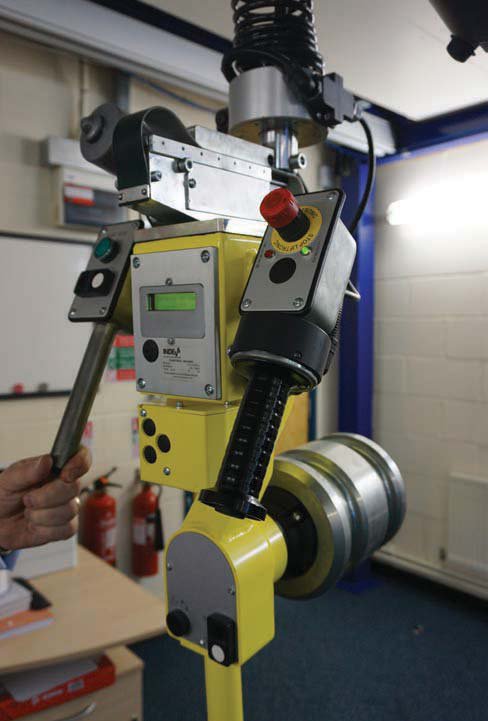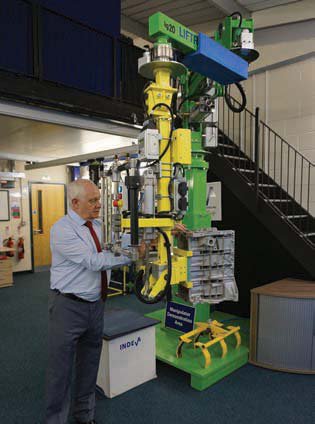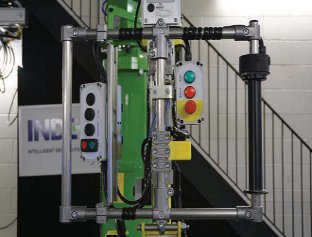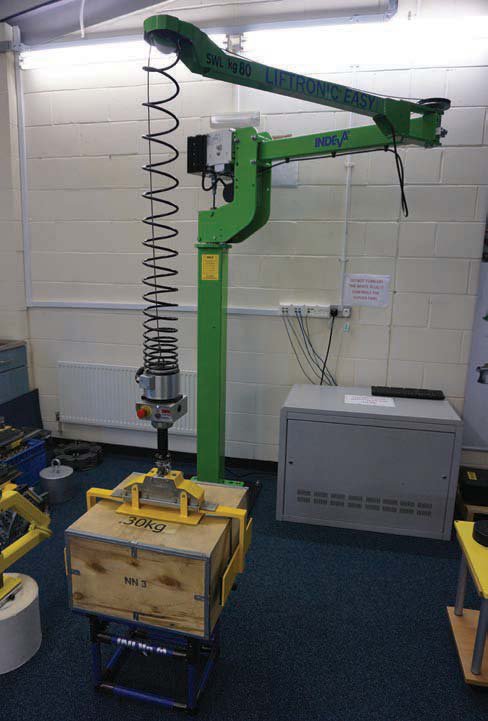A tool for every job
22 August 2018Indeva UK works with its Italian parent company to produce bespoke manual handling manipulators for almost any application. Daniel Searle visited the company.
The showroom of Indeva UK, located at Clay Cross, near Chesterfield in Derbyshire, UK is dominated by a number of intelligent manipulators, both columnmounted and on overhead bi-directional rail systems, each showcasing the different technologies available from the company.
These represent only a small proportion of what the company can produce, though—working with the technical team at Indeva in Brembilla, Italy, the company manufactures bespoke systems for applications in a huge range of sectors.
“We have a diverse customer base,” says sales director John Arrowsmith. “Two of our key sectors are automotive and aerospace, and we supply some of the biggest UK companies including Rolls-Royce and BAE. But we also supply many other sectors, including packaging and general engineering, and we’re keen to expand our supply base into new markets.”
The company’s production process enables Indeva to meet the specific needs of each customer, across this wide variety of industries.
“Most of the systems we supply are bespoke,” says Arrowsmith. “We conduct a full survey and product feasibility study for each application, to ascertain details such as the weights being lifted, the radius of the lift, the positioning of the manipulator, how regularly each lift will be repeated, and so forth.
“We then work in close collaboration with our design and development team in Italy to determine precise specifications, from which detailed drawings are produced for customer approval. The company can also provide 3D computer models to assist the customer in validating the design.”
This includes bespoke tooling for each application: “We produce a range of tooling, from hooks to mandrills, pneumatic grippers, magnets, and vacuum systems. It’s backed up by our R&D department at Brembilla.”
A recent example of a tailor-made solution was a system for Jaguar Land Rover designed to remove, test and replace batteries in finished vehicles ready for delivery after completion of a road test, which had to be flexible enough to navigate the existing car structure without causing any damage to the vehicles. Also in the automotive sector, Indeva supplied a system for fitting battery systems into hybrid cars—the batteries, each weighing around 140kg, were to be installed into partly-built cars, requiring a very steady and very accurate lifting system. The company also provides lifting systems on rails, using either KBK rails from Demag, Eco rails, or aluminium systems from Eepos. The aluminium rails have received a very good response in the automotive sector in particular, as large spans are required and such structures made from heavier materials can be hard to pull manually.
With all these options, the company can meet the requirements for most applications. “We can’t replace hoists entirely; but with loads lighter than 320kg, we can provide a more ergonomic solution,” says Arrowsmith. But there are other advantages to Indeva systems, he adds: “While hoists can be overloaded, with Indeva systems this responsibility is removed from the operator with auto weight sensing and a maximum station weight that can be applied, which prevents any lifts above that level. Our systems can also pick up loads below water level, for example. Depending on the customer’s needs and budget, we can offer a solution.”
RULES ARE RULES
As well as improving efficiency, assisted handling systems help companies to meet health and safety regulations, which are often updated and amended.
“Even lifts of 5kg can come under scrutiny from regulations if the load is being bent, turned, lifted at arm’s length, or lifted above certain heights,” says Arrowsmith. Some companies have a shop floor limit, and some use a ‘traffic light’ system to see if handling equipment is required for picking up and carrying loads, he adds—but the official health and safety regulations are more complex, and always under review.
“There’s ongoing research at the University of Nottingham,” he says. “The previous weight limit for manual handling of 25kg has now gone, and differentiating between men and women lifting loads has also gone. The regulations now look at the number of lifts being completed each day, and the muscular skeletal impact of lifts—so for example, pushing a trolley has an impact on the neck and back. Two people lifting an excess load between them also breaches the rules, because if one of them drops their side, the other person will be left holding the entire load. And ultimately, it’s the responsibility of the employer to adhere to HSE rules.
“A lot of companies have their own ergonomist, to assess the stress and effort required for different lifts,” says Arrowsmith. Beyond this, Indeva can work with customers to analyse existing working practices and determine what lifting equipment, if any, is required.
To further improve safety, Indeva’s systems incorporate a number of failsafes. The company’s Liftronic and Liftronic Air manipulators have auto-weight sensing as standard features—meaning that in the event of a sudden loss of weight on the load, the manipulator tooling is not propelled towards the operator. “We have demonstrated that our systems can lose 200kg and the tools will stay in place,” says Arrowsmith.
There are failsafes and safety checks incorporated throughout the systems, as demonstrated in the showroom, from photocell arming on a manipulator that checks the operator has a hand on the device before it can be moved, to a loadrelease button that requires a double
push, to avoid the load being dropped accidentally. There are also mechanical locks such as cam locks that activate in the case of a power outage, and the vacuum systems retain a sufficient amount of air to allow the operator to put the load down safely if the air supply stops. And the Liftronic Air system, which combines pneumatic and electronic control, prevents the operator from dialling in the wrong cylinder pressure, as can happen with fully-pneumatic systems.
THE NATIONAL HEALTH
As it often seems to be at the moment, there’s uncertainty in the UK, with the looming and currently unsettled issue of Brexit in everyone’s minds.
This has put a temporary freeze on business, says managing director Richard Wise, with orders at a stalemate.
“There was a flurry of spending after the initial Brexit vote,” says Wise, “as people wanted to invest before the uncertainty.
We’re expecting there to be more movement and investment after the deal is finalised.” “Companies are being cautious,” adds Arrowsmith, “but not because they don’t believe in the UK, but because they’re not sure about what the final Brexit deal will be. Companies are protecting profit at the moment, rather than responding to falling demand.”
He cites Jaguar and Land Rover bringing engineering back into the UK as an example of the overall landscape for UK manufacturing being in good health. With a final deal needing to be struck in the coming weeks, the British market, and Indeva UK, may well receive a welcome boost in the near future



